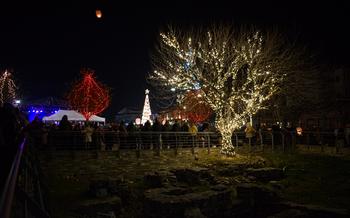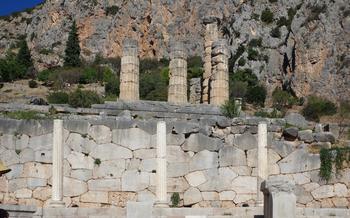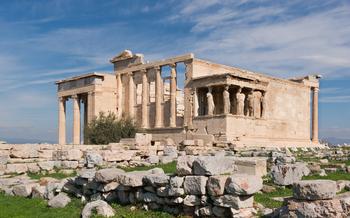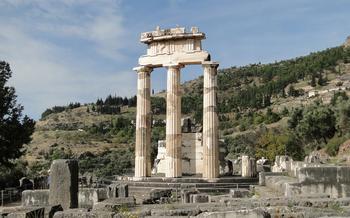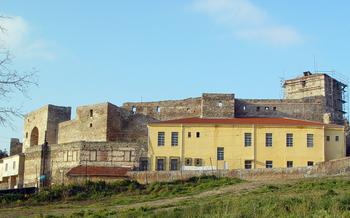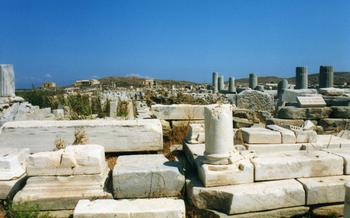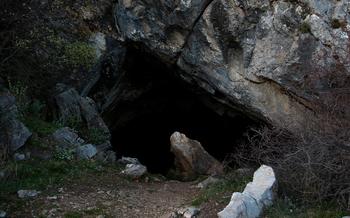
Pinios River
- The Pinios River: A Natural Wonder
- White-Water Rafting on the Pinios
- Kayaking and Canoeing on the Pinios
- Fishing on the Pinios
- Swimming in the Pinios
- Hiking and Biking Along the Pinios
- Camping Along the Pinios
- Birdwatching on the Pinios
- Visiting the Pinios Dam
- The Pinios River in Greek Mythology
- The Pinios River in Art and Literature
- The Pinios River Today
- Insider Tip: Hidden Gems of the Pinios River
The Pinios River: A Natural Wonder
The Pinios River, also known as the Peneus, is one of the longest and most significant rivers in Greece. Originating in the Pindus Mountains, it flows for over 200 kilometers through the Thessaly region before emptying into the Aegean Sea. The river has played a crucial role in Greek history, mythology, and culture for centuries.
In ancient Greek mythology, the Pinios River was associated with the god Apollo, who was said to have bathed in its waters. The river was also the site of the Battle of Pharsalus in 48 BC, where Julius Caesar defeated Pompey the Great.
Today, the Pinios River is a popular destination for outdoor recreation and nature lovers. The river's crystal-clear waters, lush vegetation, and diverse wildlife make it an ideal place for activities such as white-water rafting, kayaking, canoeing, fishing, swimming, hiking, biking, picnicking, camping, and birdwatching.
White-Water Rafting on the Pinios
The Pinios River offers a thrilling adventure for white-water rafting enthusiasts, with a variety of trips to suit all skill levels. Beginners can opt for a gentle float down the river, while more experienced rafters can tackle the challenging rapids of the lower gorges.
There are several rafting companies operating on the Pinios, offering guided trips with experienced instructors. These companies provide all the necessary equipment, including rafts, paddles, life jackets, and helmets. They also offer safety briefings and training sessions before each trip.
The difficulty level of a rafting trip is determined by the water flow rate and the number and size of the rapids. The Pinios River has sections suitable for all levels of rafters, from Class I (easy) to Class IV (difficult).
Safety is a top priority for all rafting companies. They strictly adhere to safety regulations and procedures, and their guides are trained to handle any emergency situations that may arise. Rafters are required to wear life jackets and helmets at all times, and they must follow the instructions of their guides.
Tips for Beginners
- Choose a reputable rafting company that has a good safety record.
- Be honest about your skill level and experience when booking your trip.
- Listen carefully to the safety briefing and training session before your trip.
- Follow the instructions of your guide at all times.
- Wear comfortable clothing and footwear that you don't mind getting wet.
- Bring a change of clothes and a towel in case you get soaked.
- Stay hydrated by drinking plenty of water before, during, and after your trip.
- Have fun and enjoy the experience!
Kayaking and Canoeing on the Pinios
Whether you're a seasoned paddler or a complete novice, kayaking or canoeing on the Pinios River is a fantastic way to experience the river's natural beauty and tranquility. Several types of kayaks and canoes are available for rent, from single-person kayaks to tandem canoes, so you can choose the perfect boat for your needs and experience level. Once you're on the water, you can paddle at your own pace and explore the river's many coves, inlets, and islands.
The best paddling routes on the Pinios River depend on your skill level and interests. If you're a beginner, you might want to stick to the calmer waters of the lower river, where the current is gentle and there are no major obstacles. If you're more experienced, you can venture further upriver, where the current is stronger and there are more rapids to navigate.
One of the highlights of kayaking or canoeing on the Pinios River is the opportunity to spot wildlife. The river is home to a variety of animals, including birds, fish, and turtles. If you're lucky, you might even see a beaver or an otter.
To ensure a safe and enjoyable paddling experience, follow these tips:
- Wear a life jacket at all times.
- Be aware of the weather forecast and water conditions before you go.
- Tell someone where you're going and when you expect to be back.
- Bring plenty of water and snacks.
- Be respectful of other paddlers and wildlife.
Fishing on the Pinios
The Pinios River is home to a diverse population of fish, making it a popular destination for anglers from all over the world. Some of the most common species found in the river include trout, carp, barbel, and eel. The best fishing spots are typically found in the deeper pools and eddies, as well as along the banks where there is plenty of vegetation.
Before you go fishing, be sure to obtain a fishing license from the local authorities. You will also need to be aware of the fishing regulations for the Pinios River, which include restrictions on the types of bait and tackle that can be used.
If you are new to fishing, it is a good idea to hire a local guide who can show you the best spots and techniques. You can also take a fishing class to learn the basics of the sport.
Here are some tips for a successful fishing trip on the Pinios River:
- Choose the right bait and tackle. The type of bait and tackle you use will depend on the type of fish you are targeting. For example, trout are typically caught using flies or lures, while carp are more likely to be caught using bait such as corn or bread.
- Fish early in the morning or late in the evening. These are the times when the fish are most active.
- Find a spot with plenty of cover. Fish are more likely to be found in areas with plenty of vegetation or other cover, such as rocks or fallen trees.
- Be patient. Fishing can be a slow process, so it is important to be patient and persistent.
- Enjoy the scenery. The Pinios River is a beautiful river, so take some time to enjoy the scenery while you are fishing.
Swimming in the Pinios
The Pinios River offers a variety of swimming spots for visitors to cool off and enjoy the refreshing waters. The best swimming spots are typically found in the shallow areas of the river, where the current is gentle and the water is clear. Many of these spots also have sandy beaches or grassy areas for sunbathing and relaxing.
Water quality in the Pinios River is generally good, but it can vary depending on the time of year and the weather conditions. It is always a good idea to check with local authorities or tourist information centers before swimming in the river.
When swimming in the Pinios River, it is important to be aware of the current and to avoid swimming in areas where the current is strong. It is also important to be aware of the depth of the water, as there can be deep pools in some areas of the river.
Swimmers should also be respectful of other people who are using the river. This means not swimming in areas where people are fishing or boating, and not making excessive noise or disturbing other people's enjoyment of the river.
Here are some tips for swimming safely in the Pinios River:
- Swim in designated swimming areas only.
- Obey all posted signs and warnings.
- Swim with a buddy.
- Be aware of the current and depth of the water.
- Do not swim under the influence of alcohol or drugs.
- Wear proper swimwear.
- Take breaks often to rest and rehydrate.
- Be respectful of other people who are using the river.
Hiking and Biking Along the Pinios
The Pinios River is a paradise for outdoor enthusiasts, offering a variety of hiking and biking trails that cater to all fitness levels. Whether you're a seasoned hiker or a casual cyclist, you'll find plenty of trails to explore along the river's scenic banks.
One of the most popular hiking trails is the Pinios Gorge Trail, which takes you through a stunning gorge with towering cliffs, cascading waterfalls, and lush vegetation. The trail is well-maintained and offers a moderate level of difficulty, making it suitable for hikers of all ages.
For a more challenging hike, try the Mount Olympus Trail, which takes you to the summit of Mount Olympus, the highest mountain in Greece. The trail is strenuous and requires a good level of fitness, but the views from the top are simply breathtaking.
If you prefer biking, there are several biking trails that wind along the Pinios River. One of the most popular trails is the Pinios River Bike Path, which takes you through picturesque villages, olive groves, and vineyards. The trail is mostly flat and easy to navigate, making it a great option for families with young children.
For a more challenging ride, try the Mount Olympus Bike Trail, which takes you through the rugged terrain of Mount Olympus. The trail is steep and technical, but the rewards are worth the effort, with stunning views of the surrounding mountains and valleys.
No matter what your fitness level or interests, you're sure to find a hiking or biking trail that you'll enjoy along the Pinios River. So get out there and explore this beautiful natural wonder!
Camping Along the Pinios
Camping under the stars along the banks of the Pinios River is an unforgettable experience. There are several designated camping areas along the river, offering a range of facilities and amenities to suit different needs and preferences.
The camping area at Kato Olympos is a popular choice for those seeking a tranquil and scenic setting. It is situated amidst lush greenery, with stunning views of the river and the surrounding mountains. The site offers basic facilities such as toilets, showers, and picnic tables.
For a more adventurous camping experience, the Mikrolivado camping area is an excellent option. It is located in a secluded spot, surrounded by dense forests and towering cliffs. The site is equipped with basic amenities, including toilets and water taps.
Camping along the Pinios River is a fantastic way to immerse yourself in the natural beauty of the region. Remember to follow the camping regulations and practice responsible camping etiquette, such as leaving no trace and minimizing noise pollution.
Before embarking on your camping trip, ensure you are well-prepared with the necessary gear, including a tent, sleeping bag, cooking equipment, and a first-aid kit.
Finally, always check the weather forecast before setting up camp, as the weather in the Pinios Valley can change rapidly.
Birdwatching on the Pinios
The Pinios River is a haven for birdwatchers, with a diverse array of bird species that call the river and its surrounding habitats home. From majestic birds of prey soaring overhead to colorful songbirds flitting among the trees, there is something for every bird enthusiast to enjoy.
Some of the most commonly sighted birds along the Pinios River include:
-
Kingfishers: These brightly-colored birds are often seen perched on branches overhanging the river, waiting for the perfect moment to dive down and catch a fish.
-
Dippers: These small, agile birds are adapted to life in fast-flowing rivers. They can be seen bobbing up and down in the water, searching for food.
-
Herons: These long-legged, long-beaked birds are often seen wading in the shallows, searching for fish, frogs, and other small creatures.
-
Egrets: These elegant white birds are similar to herons, but they are typically found in larger flocks. They can be seen feeding in the shallows or soaring overhead in formation.
-
Hoopoes: These distinctive birds are known for their long, curved beak and colorful crest. They can be seen foraging for insects in the fields and meadows along the river.
-
Bee-eaters: These brightly-colored birds are often seen perched on wires or branches, watching for passing bees. They will then swoop down to catch the bees in mid-air.
-
Swallows: These small, agile birds are often seen flying overhead, catching insects in their beaks. They can be seen nesting in the eaves of buildings and under bridges along the river.
-
Wagtails: These small, long-tailed birds are often seen running along the banks of the river, searching for food. They can be identified by their distinctive black-and-white plumage.
-
Warblers: These small, colorful birds are often seen flitting among the trees and bushes along the river. They can be identified by their bright plumage and their melodious songs.
Visiting the Pinios Dam
The Pinios Dam is a major engineering marvel and a popular tourist destination. Constructed in the 1950s, the dam provides much-needed water for irrigation and hydroelectric power generation. It also helps control flooding and provides a beautiful backdrop for recreational activities.
Visitors can take a guided tour of the dam to learn about its history, construction, and operation. The tour includes a walk along the dam's crest, where you can enjoy stunning views of the reservoir and the surrounding countryside.
In addition to the dam itself, there are several other attractions in the area. The Pinios Dam Visitor Center has exhibits on the dam's history and construction, as well as the natural history of the Pinios Valley. There are also several hiking trails and picnic areas in the vicinity.
Tips for visiting the Pinios Dam:
- Book a guided tour in advance. Tours are available in several languages and typically last about an hour.
- Wear comfortable shoes and clothing. You will be doing a lot of walking, so it is important to be comfortable.
- Bring sunscreen, water, and a hat. The sun can be intense, especially during the summer months.
- Be respectful of the dam's workers. The dam is a working facility, so it is important to be mindful of the workers and their safety.
The Pinios River in Greek Mythology
In Greek mythology, the Pinios River was considered a sacred body of water, deeply entwined with the realm of the gods and heroes. According to legend, the river was the birthplace of the centaurs, mythical creatures with the upper body of a human and the lower body of a horse. The centaurs were known for their wild and untamed nature, and the Pinios River was said to be their favorite haunt.
The Pinios River in Art and Literature
The Pinios River has served as a muse to artists and writers for centuries. Its beauty, history, and mythology have been captured in paintings, sculptures, poems, stories, and novels. One of the most famous works of art inspired by the river is the painting "The Valley of the Peneios" by Nicolas Poussin. This 17th-century masterpiece depicts the river winding through a lush valley, surrounded by mountains and forests. The painting is known for its idyllic depiction of nature and its use of classical mythology.
Another famous work of art inspired by the Pinios is the sculpture "The Abduction of Persephone" by Gian Lorenzo Bernini. This 17th-century sculpture depicts the moment when Hades, the god of the underworld, abducts Persephone, the daughter of Demeter, the goddess of agriculture. The sculpture is a powerful and dramatic representation of the myth and shows the river as a witness to the event.
In literature, the Pinios River has been featured in many works, including the ancient Greek poem "The Odyssey" by Homer. In this epic poem, the river is mentioned as one of the boundaries of the underworld. The river is also mentioned in the works of other ancient Greek writers, such as Hesiod, Pindar, and Sophocles.
In modern times, the Pinios River has continued to inspire artists and writers. The Greek poet Nikos Kazantzakis wrote about the river in his novel "Zorba the Greek." In this novel, the river is a symbol of life and renewal. The river is also featured in the works of other modern Greek writers, such as George Seferis and Odysseus Elytis.
The Pinios River is a source of inspiration for artists and writers because of its beauty, history, and mythology. The river has been captured in works of art and literature for centuries and continues to inspire new generations of artists and writers.
The Pinios River Today
The Pinios River faces several challenges today, including pollution from agricultural runoff, urbanization, and industrial development. Climate change also poses a threat to the river, as it is expected to lead to decreased water flow and more extreme weather events.
Conservation and restoration efforts are underway to address these challenges. Local initiatives, such as the Pinios River Cleanup Project, are working to reduce pollution and restore the river's natural habitat. The Greek government has also designated the Pinios River as a Natura 2000 site, which provides legal protection for its unique biodiversity.
Despite the challenges it faces, the Pinios River remains a vital resource for the people and wildlife of Greece. Local communities are working together to protect the river and ensure its future sustainability.
The future of the Pinios River is bright. With continued conservation and restoration efforts, the river can be restored to its former glory and continue to provide a source of water, recreation, and inspiration for generations to come.
Insider Tip: Hidden Gems of the Pinios River
Beyond the well-known attractions, the Pinios River offers a treasure trove of hidden gems for those willing to explore. One such secret is the secluded swimming spot known as "Mermaid's Cove," nestled amidst lush greenery and crystal-clear waters. For hikers seeking solitude, the "River's Edge Trail" winds along the riverbank, offering breathtaking views and encounters with rare wildflowers.
For wildlife enthusiasts, the "Eagle's Nest" viewpoint provides a chance to witness majestic eagles soaring above the river. And for those seeking a truly unique experience, a visit to the "Ancient Olive Grove" reveals centuries-old olive trees, a testament to the region's rich history. Discover these hidden gems and create lasting memories along the Pinios River.
